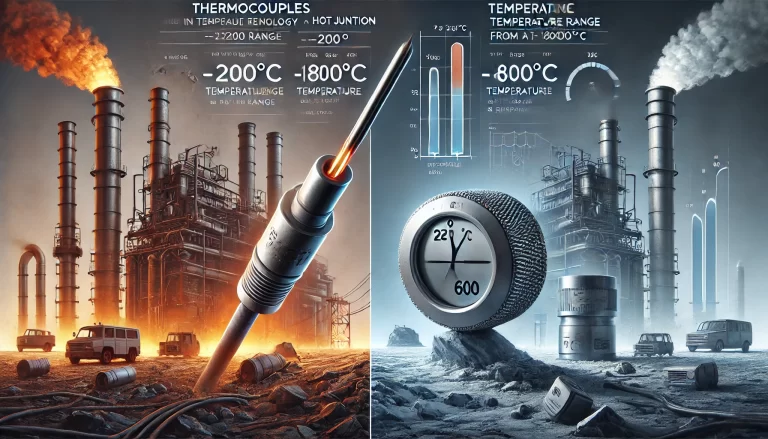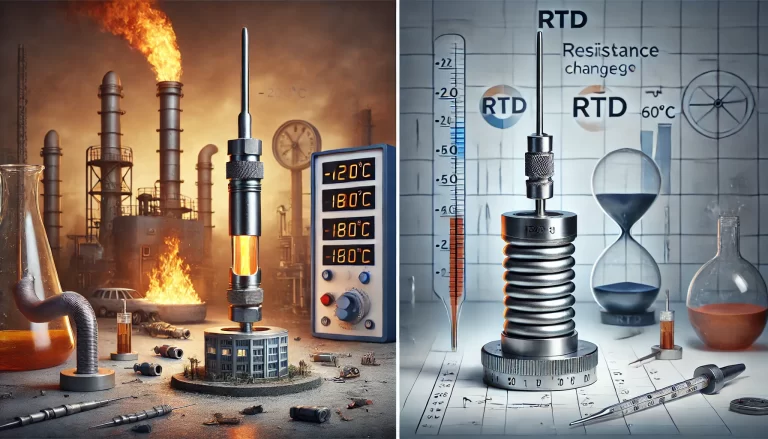Thermocouples (T/Cs) and resistance temperature detectors (RTDs) are widely used in various industries to measure temperature. While they both serve the same purpose, their underlying technology, performance, and applications vary significantly. Here’s a detailed breakdown of the differences between thermocouples and RTDs:
1. Operating Principle
Thermocouples:
- Thermocouples operate based on the Seebeck effect, where a voltage is generated at the junction of two dissimilar metals when there is a temperature difference between the junction and the reference point (cold junction). This voltage is proportional to the temperature difference, and by measuring the voltage, the temperature at the junction can be determined.
- Thermocouples consist of two wires made of different metals, welded together at one end to form the measuring (hot) junction.
RTDs:
- RTDs (Resistance Temperature Detectors) work on the principle that the electrical resistance of a metal increases or decreases in a predictable way with temperature. The most commonly used RTD material is platinum, which has a well-defined and consistent resistance-to-temperature relationship.
- The most common RTDs are platinum RTDs, such as Pt100 (which has a resistance of 100 ohms at 0°C) or Pt1000 (1000 ohms at 0°C).

2. Temperature Range
Thermocouples:
- Thermocouples can measure a wide range of temperatures, from very low (-200°C) to extremely high temperatures (up to 1800°C, depending on the thermocouple type).
- For example:
- Type K (Nickel-Chromium / Nickel-Aluminum): -200°C to 1200°C.
- Type J (Iron / Constantan): -40°C to 750°C.
- Type S (Platinum / Rhodium): 0°C to 1600°C.
RTDs:
- RTDs have a narrower temperature range compared to thermocouples. Typically, they are used in the range of -200°C to 600°C.
- Pt100 RTDs are common in this range and are chosen for their precision at low to moderate temperatures.
3. Accuracy and Precision
Thermocouples:
- Thermocouples are generally less accurate than RTDs. Their accuracy can be influenced by many factors, including the condition of the thermocouple, calibration, and the cold junction compensation method used.
- Accuracy can vary between 1°C to 5°C, depending on the type of thermocouple and environmental factors. Thermocouples are also more prone to signal drift over time.
RTDs:
- RTDs are known for their high accuracy and precision. Platinum RTDs, in particular, are highly stable over time and can offer accuracies as fine as 0.1°C to 0.5°C, making them ideal for precise temperature measurements in critical applications like laboratories or industrial processes where temperature control is vital.

4. Response Time
Thermocouples:
- Thermocouples have a faster response time due to their simple construction and the smaller mass of the junction point. They are better suited for applications where rapid temperature changes occur and quick readings are required.
- Response time can be as fast as 0.1 to 1 second, depending on the design (such as exposed junctions).
RTDs:
- RTDs, due to their larger physical structure and the need for protection (like a protective casing), generally have a slower response time compared to thermocouples.
- Typical response times can range from 0.5 to 5 seconds, depending on the specific sensor and installation.
5. Durability and Environmental Resistance
Thermocouples:
- Thermocouples are more robust and can withstand extreme environments, including high temperatures, vibrations, and corrosive environments. They can be built using materials that are resistant to corrosion and oxidation, making them suitable for industrial applications in harsh conditions.
- However, prolonged exposure to high temperatures can cause degradation of the metals in the thermocouple, leading to signal drift over time.
RTDs:
- RTDs are less durable in extreme environments. They are sensitive to mechanical shock and vibration, which can damage the fine wire or alter the sensor’s calibration. They are not suitable for very high temperatures or corrosive environments unless housed in specialized protective sheaths.
- However, for stable, low-to-moderate temperature environments, RTDs have excellent longevity and stability.
6. Signal and Output
Thermocouples:
- Thermocouples produce a millivolt output that is proportional to the temperature difference between the hot junction and the cold junction. The voltage is small (usually less than 100mV for typical industrial applications), requiring high-precision instrumentation for accurate readings.
- Additionally, thermocouples are non-linear, which means that the voltage-to-temperature relationship must be linearized either through lookup tables or calibration curves.
RTDs:
- RTDs provide a resistance change in ohms as the temperature changes. The relationship between resistance and temperature, particularly in platinum RTDs, is nearly linear, simplifying the interpretation of readings.
- Because of the higher output resistance (compared to thermocouple millivolt signals), RTD signals are easier to read, and less sophisticated electronics are required for signal amplification.

7. Cost
Thermocouples:
- Thermocouples are generally cheaper than RTDs, especially when considering their wide temperature range and durability. They are widely available and are often the first choice in budget-constrained applications or those requiring high-temperature measurements.
RTDs:
- RTDs are more expensive, particularly platinum-based RTDs. However, their higher cost is justified by their superior accuracy, stability, and longer lifespan in suitable environments. They are often used in high-precision applications where accuracy and consistency are more important than cost.
8. Applications
Thermocouples:
- Thermocouples are preferred in applications where high temperatures, rapid response, and ruggedness are critical. Common use cases include:
- Industrial furnaces and kilns.
- Gas turbine exhaust measurement.
- Chemical processing and petrochemical plants.
- Engine testing and combustion environments.
RTDs:
- RTDs are used in applications where precision and stability over time are crucial. Typical applications include:
- Laboratory and research settings.
- HVAC systems.
- Food and pharmaceutical industries.
- Industrial processes where moderate temperatures are monitored, such as cooling systems.

Conclusion
Choosing between a thermocouple and an RTD depends on the specific requirements of the application. Thermocouples offer a broader temperature range, faster response times, and greater durability in extreme environments, making them ideal for high-temperature and industrial settings. On the other hand, RTDs provide superior accuracy and stability in low-to-moderate temperature environments, making them the better choice for applications requiring precise, reliable temperature readings over time.
For high-precision measurements in controlled environments, RTDs are often the preferred option, while thermocouples excel in rugged, high-temperature scenarios. Ultimately, the decision hinges on the trade-offs between accuracy, temperature range, response time, and environmental conditions.
